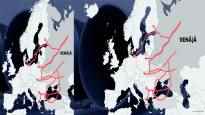Russia’s invasion of Ukraine pushes EU countries into a climate change. With hard work, the EU could get rid of Russian energy as early as this year, but it would cost malt, writes financial journalist Anna Karismo.
26.3. 12:25 • Updated March 26. 12:31
The EU is now feverishly looking for ways to get rid of Russian imported energy. The first big step in Russia’s exit from oil, gas and coal was taken on Friday, when the United States promised to replace virtually all of its liquefied petroleum gas.
President Joe Biden according to the United States deliver (switch to another service) 15 billion cubic meters of liquefied natural gas (LNG) for the EU this year. It roughly corresponds to the amount of liquefied petroleum gas imported from Russia last year.
From digital to climatic
Where the corona pandemic pushed EU countries to telecommuting and digital leaps, the Ukrainian war will steer them to climate leaps faster than planned.
Fossil fuels are being imported from Russia, and as a result of the war, they are likely to switch to renewable energy sources faster than the EU has sought.
The EU is set to completely disengage from fossil fuels imported from Russia in the coming years.
By the end of this year, the European Commission wants to replace most of the natural gas imported from Russia. The biggest job is filling up gas storage by the fall to ensure home heating next winter.
The graphic below shows how the gap left by Russian gas could be filled. The European Commission and the International Energy Agency (IEA) have made their own calculations of the need for new energy.
Russia’s attack is accelerating the introduction of all technologies that can replace fossil fuels with renewable energy. For example, reducing heating would make a large part of Russian imports unnecessary.
There are interesting differences between the pillars of the Commission and the IEA. The EU Commission, for example, believes that as much as 50 billion cubic meters of liquefied petroleum gas can be sourced from the rest of the world.
The Commission also does not rely on coal at all, while the IEA says it should be clearly increased during the transition.
Theory is different from practice
Combining EU and IEA proposals to replace natural gas will get close to the amount of gas imported from Russia last year. At least in theory, then, the EU could be able to end its dependence on Russia this year.
However, it is very difficult to put the blows off at once. Brainstorming Bruegel (switching to another service) without Russian gas, it is possible to survive, but it will require difficult decisions.
Due to Putin’s attack, “everyone” now has an interest in investing in their own energy production and demand is already at its peak, the Finnish Energy Industry Association estimates. In contrast, the ability to produce new types of energy technologies is limited.
– Gas is already costing a lot in Europe and there is a great desire to replace it. [Uuden teknologian] there are buyers, but I wonder if somewhere there is the capacity to suddenly install much more solar panels or heat pumps in Europe, CEO of the Energy Industry Jukka Leskelä says.
You can discuss the topic until 11 p.m., Sunday night.
